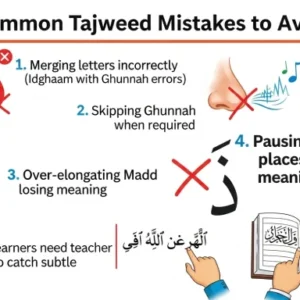Expanded Content on Tajweed Science provides Muslims in the UK with a clear, structured, and spiritual guide to perfecting Quran recitation.
Tajweed is not just a set of rules it is the foundation that ensures the words of Allah are recited exactly as revealed.
Whether you are a new Muslim, a child growing up in the UK, or an adult seeking to refine your recitation, Tajweed Science connects you directly to the divine message.
What Is Tajweed Science?
Tajweed (تجويد) comes from the Arabic root “jawwada,” meaning “to improve or make better.” In Islamic studies, Tajweed refers to the precise rules governing pronunciation when reciting the Quran.
-
It ensures every letter is articulated from its correct position.
-
It preserves the integrity and meaning of the Quranic message.
-
It is both a technical science and a spiritual practice.
In simple terms: Tajweed guarantees that the Quran is recited as the Prophet ﷺ taught his companions.
Why Tajweed Matters in Quran Recitation?
The Quran is not an ordinary book; it is divine revelation. Mispronunciation can alter meanings, which is why Tajweed is essential.
-
✅ Correct articulation of every letter.
-
✅ Protection from errors that distort meaning.
-
✅ A way to honor and show reverence for Allah’s words.
“And recite the Quran with measured recitation.” (Quran 73:4)
For Muslims in the UK, learning Tajweed is both a duty and a source of spiritual connection, especially in daily Salah and personal recitation.
🎯 Looking to begin? Start with our Online Quran Classes taught by Azhar-certified teachers online.
Mastering Quran Recitation in the UK:
Muslims in Britain now have more opportunities than ever to study Tajweed with expert teachers online.
-
1:1 online sessions with Azhar-certified tutors.
-
Flexible scheduling for children, professionals, and parents.
-
Practice-based learning with personalized correction.
-
Affordable monthly plans and two free trial lessons.
🎓 Ready to improve? Start your journey today with our Online Quran Classes.
Core Objectives of Tajweed Science:
The science of Tajweed has three primary objectives that every learner must aim to achieve:
-
Correct Letter Articulation – From throat letters to nasal sounds.
-
Rhythm and Flow – Balanced elongations and controlled pauses.
-
Beautification of Recitation – Melodic recitation inspired by the Prophet ﷺ and great reciters.
Perfect your Quran recitation with Tajweed Science
start online today in the UK!
Table: Key Components of Tajweed
| Rule Category | Description |
|---|---|
| Makharij (Articulation) | How each letter is produced from its specific place in the mouth or throat |
| Sifaat (Qualities) | Characteristics of letters: heaviness, softness, echo |
| Ghunnah | Nasalization in Noon and Meem |
| Madd (Elongation) | Extending vowels for 2, 4, or 6 counts |
| Qalqalah | Echo effect when certain letters are pronounced at stops |
| Waqf & Ibtida | Rules of pausing and restarting recitation |
Sakt in Quran: The Special Pause
A unique rule of Tajweed is Sakt (a very short pause without breaking breath).
-
Found in Surahs like Al-Kahf and Al-Qiyamah.
-
Adds a reflective, rhythmic moment to recitation.
-
Misunderstood by many learners, but clarified through Tajweed study.
This rule is especially important for advanced learners in the UK who want to recite with depth and fluency.
Ikhfa’: The Beauty of Concealed Pronunciation
Ikhfa’ (إخفاء) is one of the most elegant rules in Tajweed.
-
Happens when Noon Saakinah or Tanween is followed by one of 15 letters.
-
The sound is “hidden” between full clarity and merging.
-
Produces a soft, smooth tone that beautifies recitation.
Ikhfa’ Shafawi Example
When Meem Saakinah is followed by Ba (ب):
رَبَّهُم بِهِم → pronounced with a light nasal concealment.
This subtlety is what separates beginner reciters from masters.
Global Impact of Tajweed Reciters:
The world’s most beloved reciters all mastered Tajweed:
-
Shaykh Mahmoud Khalil Al-Husary (Egypt)
-
Shaykh Abdul Basit Abdul Samad (Egypt)
-
Shaykh Mishary Rashid Alafasy (Kuwait)
Their voices became:
-
📖 Tools for Dawah worldwide.
-
🌙 Sources of spiritual healing.
-
🎶 Models for millions of learners in the UK and beyond.
How to Learn Tajweed Effectively:
Tajweed is both an art and a science. Here’s the recommended learning path:
-
📌 Learn with a qualified Tajweed teacher — correction is vital.
-
📌 Study rules step by step — from articulation to advanced topics.
-
📌 Practice 10–15 minutes daily.
-
📌 Record and compare your recitation with experts.
-
📌 Reflect on meanings — Tajweed is not only about sound.
🎯 Start today with our Online Quran Classes
Perfect your Quran recitation with Tajweed Science
start online today in the UK!
Advanced Tajweed Topics to Explore:
-
Tafkheem & Tarqeeq: Heavy vs. light sounds in letters like ر.
-
Idghaam Types: Complete vs. incomplete merging.
-
Hamzatul Wasl & Qat’: Rules for starting words.
-
Tanween Variations: End-of-verse pronunciation.
Table: Levels of Tajweed Mastery
| Level | Description | Learning Focus |
|---|---|---|
| Beginner | Reads slowly with errors | Letter recognition, Makharij |
| Intermediate | Basic Tajweed, needs correction | Madds, Ghunnah, Qalqalah |
| Advanced | Fluent, rhythmic | Sakt, Waqf, flow |
| Master | Inspiring, flawless recitation | Emotional delivery, spiritual depth |
Common Tajweed Mistakes to Avoid:
-
❌ Merging letters incorrectly (Idghaam errors).
-
❌ Skipping Ghunnah.
-
❌ Over-stretching Madd.
-
❌ Pausing at wrong places.
Even advanced UK learners benefit from teacher feedback to avoid these subtle errors.
The Spiritual Impact of Perfect Recitation:
Perfecting Tajweed is not only technical — it transforms your spiritual life:
-
Deepens your connection with the Quran.
-
Makes Salah more meaningful.
-
Brings peace during times of hardship.
“Those who recite the Book of Allah… will be rewarded without limit.” (Quran 35:29)
Why Learn Tajweed with Quranic Academy?
At Quranic Academy we make Tajweed accessible to every Muslim in the UK:
-
📖 Azhar-trained teachers with years of experience.
-
🖥️ 1:1 online sessions tailored to your pace.
-
🎤 Real-time correction of pronunciation.
-
🌙 Spiritual and technical growth combined.
-
🎁 Two free trial lessons before enrollment.
💡 Whether you are a beginner or aiming for mastery, Quranic academy will guide you every step of the way.
Frequently Asked Questions:
❓ What is the fastest way to master Tajweed?
➡️ Structured practice with a qualified teacher. Avoid relying on self-study alone.
❓ Can I learn Tajweed online in the UK?
➡️ Yes. Online classes with real-time correction are often better than large group sessions.
❓ How long does it take to become fluent?
➡️ Most students see progress within 3–6 months of consistent practice.
❓ Is Tajweed required in Salah?
➡️ Yes. Incorrect pronunciation may change meaning and affect the validity of Salah.
❓ Are online Tajweed classes good for kids in the UK?
➡️ Absolutely. Interactive teaching makes learning engaging for children.
❓ Do I need to know Arabic before Tajweed?
➡️ No. Tajweed focuses first on correct sounds and then on fluency.
Final Thoughts
Expanded Content on Tajweed Science is about more than memorizing rules — it is about reviving the Quran in your heart. By studying Tajweed, you continue the tradition of the Prophet ﷺ and the world’s greatest reciters.
🎯 Ready to improve your recitation?
👉 Enroll in our Online Quran Classes today and transform your connection with the Quran.
Perfect your Quran recitation with Tajweed Science
start online today in the UK!




